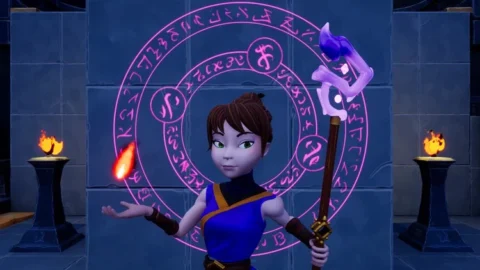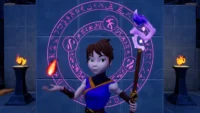
Copy this code and use at checkout
82% Off Unreal Engine 5 – Gameplay Ability System – Top Down RPG Udemy coupon
Expires: No Expires
Submitted: 3 months ago
Course Overview
This comprehensive course, “Unreal Engine 5: Top-Down RPG with Gameplay Ability System,” developed by Stephen Ulibarri, aims to teach intermediate to advanced Unreal Engine developers how to architect and implement a production-ready, multiplayer RPG using Unreal Engine’s built-in Gameplay Ability System (GAS). Spanning over 100 hours of on-demand video, it focuses on building a scalable, modular, and maintainable codebase following “SOLID coding principles and AAA quality code architecture.” The course emphasizes the crucial decision-making process for balancing C++ and Blueprint functionality for optimal performance in shipped games.
Main Themes and Key Takeaways
1. Mastering the Gameplay Ability System (GAS)
The central theme of the course is the in-depth exploration and practical application of Unreal Engine’s Gameplay Ability System (GAS). The course promises to cover “All core features of the Gameplay Ability System,” including:
- Core Classes: Understanding the fundamental components of GAS, such as Gameplay Ability System Components, Attribute Sets, Gameplay Effects, and Gameplay Tags.
- Attributes: Implementing player and enemy stats using Primary Attributes (Strength, Intelligence, Resilience, Vigor), Secondary Attributes (Armor, Armor Penetration, Block Chance, Critical Hit Chance/Damage/Resistance, Health/Mana Regeneration, Max Health/Mana), and Vital Attributes (Health, Mana). The course details how these attributes are replicated and integrated into gameplay mechanics through an “Effect Application pipeline.”
- Gameplay Abilities: Creating various types of abilities, including “Offensive Spells” (FireBolt, Electrocute, Arcane Shards, FireBlast) and “Passive Spells,” covering “Ability Cost and Cooldown.” This forms “the heart of GAS.”
- Gameplay Effects & Tags: Utilizing “Gameplay Effects” to apply attribute changes and “Gameplay Tags” for comprehensive identification of game elements like qualities, attributes, abilities, and character classes.
2. AAA-Quality Code Architecture and Best Practices
A significant focus is placed on teaching industry-standard coding practices for creating robust and maintainable game projects. The course addresses common developer questions regarding code architecture:
- C++ vs. Blueprints: A core lesson is “How to choose which functionality should go into C++ versus Blueprint.” Ulibarri states, “This project is architected with approximately 50% Blueprints and 50% C++. I show you which functionality should be on the C++ side, which functionality is more appropriate for Blueprints, and why.” This aims to replicate the balance seen in “AAA shipped games, such as Fortnite.”
- SOLID Principles: The course rigidly adheres to “SOLID coding principles and AAA quality code architecture” to ensure a “clean, modular, maintainable, and expandable code that can serve as the foundation for any serious game.”
- Scalability and Maintainability: The architecture is designed to be “easily expanded, upgraded, and maintained,” providing a foundation for “serious-scale project.”
3. Comprehensive RPG System Implementation
The course guides students through building a full-fledged top-down RPG, covering all essential mechanics:
- Multiplayer Gameplay: The course explicitly states it will “Create a multiplayer RPG” and covers “Multiplayer Gameplay Mechanics.”
- Combat System: A “full RPG style combat system” is implemented, including “different damage types, damage resistances, and debuffs.” Visual feedback for combat, such as “floating text for damage… critical hits, blocked hits, and critical blocked hits,” along with “knockback and stun mechanics,” are also covered.
- Experience & Level-Up System: A complete “experience system, awarding XP for eliminating enemies, and leveling up when reaching XP thresholds.” This includes gaining “Attribute Points and Spell Points” upon leveling up.
- Character Classes: Implementation of “different RPG Classes including the Ranger, Warrior, and Elementalist,” designed for “easily-scalable manner.”
- User Interface (UI): Detailed instruction on “how to handle complex UI in an RPG game efficiently, in an organized, modular, and scalable manner,” including “different UI paradigms, from MVC… and MVVM.”
- Enemy AI: Utilizing “Unreal Engine Behavior Trees and the Environment Query system (EQS) to provide customized behavior for the Ranged, Warrior, and Elementalist enemy types.” Enemies can also “cast spells and summon AI minions.”
- Game Saving & Progress: Functionality for “Saving Progress and Level Transitions” is included.
4. Advanced Unreal Engine Concepts
Beyond the core RPG mechanics, the course delves into various intermediate and advanced Unreal Engine topics to equip developers with a broader skillset:
- Customization: “Custom Gameplay Ability System Components and Attribute Sets,” “Custom Async Tasks, Ability Tasks, Blueprint Function Libraries, Asset Managers.”
- Performance & Optimization: Understanding where to draw the line between C++ and Blueprints for “optimal performance in a shipped game.”
- Debugging: Inclusion of “Code debugging tools and practices.”
- Specific Engine Features: “Fading geometry when it gets in the way of the camera for a top-down game,” “Net Serialization, Struct Ops Type Traits, C++ Lambdas, game mechanics algorithms.”
Target Audience and Prerequisites
This course is not for beginners. It explicitly states, “This is not a beginner course. I expect you to already understand the C++ programming language and have at least created one Unreal Engine C++ project.”
The ideal candidates for this course include:
- Developers looking to architect “a scalable and shippable game in Unreal Engine.”
- Those seeking a “comprehensive course on the Gameplay Ability System (GAS).”
- Developers aiming to implement complex systems like “gameplay Attributes, Abilities, Experience, Level Ups, and how to maintain these in a clean code base.”
- Individuals interested in creating various game genres beyond RPGs, such as “MOBA, Shooter Game, or any other type of game involving attributes, skills, spells, or other custom mechanics.”
- “Hobbyists and Professional Game Developers alike,” including “AAA developers who need to learn the fundamentals of GAS” and “Leaders of game development projects.”
Instructor Background
Stephen Ulibarri, the course creator, holds a bachelor’s degree in Chemical Engineering, which exposed him to programming. He has “professional industry experience in the world of surgical simulations” and is passionate about game development and problem-solving. He is the founder of the “Druid Mechanics Game Developer Community” and has authored a book on Unreal Engine C++. His experience is leveraged to reveal “the way a real shipped game’s code base looks like.”
Included Assets
The course provides a custom asset pack specifically designed for the project, which includes:
- Characters: Aura (main character), Goblin Warriors, Goblin Rangers, Goblin Shaman, Red and Black Demons, Ghoul, Shroom.
- Environments: A modular dungeon pack, waypoint shrine, and obelisks.
- VFX: “Particle Niagara System Effects, including explosions, level up effects, slingshot rocks, hit impacts, electricity beams, fireballs, fire bolts, flames, stars for stun effects, and more!”
- SFX: “Sound effects for enemies, footsteps, spells, and more!”
- UI Textures: “high-quality buttons, frames, dynamically-animated spell globes, progress bars, XP bar, and more!”
- Animations: “Full animation sets for Aura and all enemies.”
Conclusion
“Unreal Engine 5: Top-Down RPG with Gameplay Ability System” is presented as a definitive guide for creating sophisticated, production-quality games in Unreal Engine 5. Its emphasis on the Gameplay Ability System, robust code architecture, and practical implementation of complex RPG mechanics positions it as a valuable resource for intermediate to advanced developers seeking to elevate their game development capabilities and understand how professional games are built.
Frequently Asked Questions
What is the “Unreal Engine 5: Top-Down RPG with Gameplay Ability System” course about?
This comprehensive course, created by Stephen Ulibarri, focuses on teaching advanced Unreal Engine 5 development, specifically through the creation of a multiplayer, top-down RPG. A core theme is the in-depth utilization of Unreal Engine’s built-in Gameplay Ability System (GAS) for handling mechanics like combat, experience, level-ups, spells, and character attributes. It emphasizes best practices for code architecture, including the optimal balance between C++ and Blueprints for scalable, maintainable, and shippable games.
Who is this course designed for, and what are the prerequisites?
This course is for intermediate to advanced Unreal Engine developers, both hobbyists and professionals, who want to create complex, shippable games. It’s particularly useful for those interested in implementing robust gameplay systems like attributes, abilities, and AI, or for teams looking to architect scalable projects. A strong understanding of C++ programming and prior experience with at least one Unreal Engine C++ project are required, as it is not a beginner’s course.
What key technical skills and concepts will be covered in the course?
The course delves into numerous advanced Unreal Engine topics, including:
- Gameplay Ability System (GAS): Comprehensive coverage of core GAS classes, components, attributes (primary, secondary, vital), gameplay effects, and gameplay tags.
- Multiplayer Mechanics: Designing and implementing features for a multiplayer environment.
- Code Architecture: Applying SOLID coding principles, object-oriented programming (OOP), inheritance, and mastering the C++/Blueprint ratio for AAA quality code.
- Combat System: Implementing RPG-style combat with different damage types, resistances, debuffs, visual feedback (floating text), and mechanics like knockback and stun.
- AI Implementation: Utilizing Unreal Engine’s Behavior Trees and Environment Query System (EQS) for diverse enemy AI behaviors, including spell casting and minion summoning.
- UI/UX: Handling complex RPG UI efficiently using paradigms like MVC and MVVM (with Unreal’s ViewModel feature), including spell and attribute menus.
- Advanced Engine Topics: Custom Async Tasks, Ability Tasks, Blueprint Function Libraries, Asset Managers, Net Serialization, and more.
What kind of RPG features will be built and implemented in the course project?
Students will build a full RPG featuring:
- A robust combat system with various damage types and visual feedback.
- An experience and level-up system with attribute and spell points.
- Diverse spells (offensive, passive) with cost and cooldown mechanics.
- Character attributes (Strength, Intelligence, Vigor, Resilience, Armor, Critical Hit Chance, etc.).
- Different RPG classes (Ranger, Warrior, Elementalist).
- Enemy AI that can cast spells and summon minions.
- A fully functional HUD displaying spells, cooldowns, and XP.
- Game saving and level transitions.
- Modular environments and a variety of custom assets (characters, animations, VFX, SFX).
How does the course address the C++ versus Blueprint debate in Unreal Engine development?
A central and highly valuable aspect of the course is its direct answer to the question of where to draw the line between C++ and Blueprints. The project is architected with an approximate 50% Blueprint and 50% C++ split, mirroring industry best practices from AAA shipped games like Fortnite. Stephen Ulibarri, drawing on his professional experience and industry consultations, explicitly demonstrates and explains which functionalities are best suited for C++ and which for Blueprints, providing a practical guide for optimal performance and maintainability.
What is the significance of the Gameplay Ability System (GAS) in this course?
The Gameplay Ability System (GAS) is positioned as the heart of the course and a fundamental tool for creating robust gameplay mechanics in Unreal Engine. Students will learn how to leverage GAS to architect flexible and powerful systems for abilities, attributes, and effects, which are crucial for any serious game involving complex player and enemy interactions, especially in RPG, MOBA, or shooter genres. Its proper implementation is key to creating scalable and maintainable game logic.
What is Stephen Ulibarri’s background and teaching philosophy?
Stephen Ulibarri holds a bachelor’s degree in Chemical Engineering and has professional industry experience in surgical simulations. He is the founder of the Druid Mechanics Game Developer Community and has authored an Unreal Engine C++ book. His teaching philosophy emphasizes passing on practical, “AAA quality” knowledge derived from real-world experience and industry consultations, focusing on clean, modular, and scalable code architecture. He aims to empower students to create well-architected projects of any scale.
What resources are provided with the course?
The course is extensive, offering 106 hours of on-demand video, 3 articles, and 3 downloadable resources. It includes full lifetime access, mobile and TV access, and a certificate of completion, backed by a 30-day money-back guarantee. Crucially, it provides a comprehensive asset pack made specifically for the course, containing custom characters, a modular dungeon pack, particle effects, sound effects, HUD textures, and full animation sets, enabling students to build a visually rich and functional game.


Loading comments....